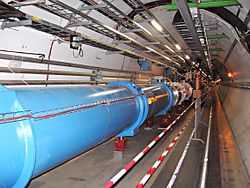Exotic baryon
| Standard Model of particle physics |
|---|
 Large Hadron Collider tunnel at CERN |
|
Constituents |
|
Limitations |
|
Scientists Rutherford · Thomson · Chadwick · Bose · Sudarshan · Koshiba · Davis, Jr. · Anderson · Fermi · Dirac · Feynman · Rubbia · Gell-Mann · Kendall · Taylor · Friedman · Powell · P. W. Anderson · Glashow · Meer · Cowan · Nambu · Chamberlain · Cabibbo · Schwartz · Perl · Majorana · Weinberg · Lee · Ward · Salam · Kobayashi · Maskawa · Yang · Yukawa · 't Hooft · Veltman · Gross · Politzer · Wilczek · Cronin · Fitch · Vleck · Higgs · Englert · Brout · Hagen · Guralnik · Kibble · Ting · Richter |
Exotic baryons are hypothetical composite particles that are bound states of 4 or more quarks and additional elementary particles. This is to be contrasted with ordinary baryons, which are bound states of just 3 quarks. The additional particles may include quarks, antiquarks or gluons.
The exotic baryon with the strongest experimental support is the tetraquark particle Z(4430), which was discovered by the Belle experiment and recently confirmed by LHCb at 13.9 sigma. Previously more ambiguous detections have been claimed for other exotic baryons, such as the pentaquark, which consists of four quarks and an antiquark.[1] Another hypothetical exotic baryon that consists only of quarks is the H dibaryon,[2][3] which consists of two up quarks, two down quarks and two strange quarks. Unlike the pentaquark, this particle might be long lived or even stable. There have been unconfirmed claims of detections of pentaquarks and dibaryons.[4][5]
Several types of exotic baryons that require physics beyond the Standard Model have been conjectured in order to explain specific experimental anomalies. There is no independent experimental evidence for any of these particles. One example is supersymmetric R-baryons,[6] which are bound states of 3 quarks and a gluino. The lightest R-baryon is denoted as  and consists of an up quark, a down quark, a strange quark and a gluino. This particle is expected to be long lived or stable and has been invoked to explain ultra-high-energy cosmic rays.[7][8] Stable exotic baryons are also candidates for strongly interacting dark matter.
and consists of an up quark, a down quark, a strange quark and a gluino. This particle is expected to be long lived or stable and has been invoked to explain ultra-high-energy cosmic rays.[7][8] Stable exotic baryons are also candidates for strongly interacting dark matter.
It has been speculated by futurologist Ray Kurzweil that by the end of the 21st century it might be possible by using femtotechnology to create new chemical elements composed of exotic baryons that would eventually constitute a new periodic table of elements in which the elements would have completely different properties than the regular chemical elements.[9]
References
- ↑ D. Diakonov, V. Petrov, M. Polyakov (1997). "Exotic Anti-Decuplet of Baryons: Prediction from Chiral Solitons". Zeitschrift für Physik A 359 (3): 305–314. arXiv:hep-ph/9703373. Bibcode:1997ZPhyA.359..305D. doi:10.1007/s002180050406.
- ↑ G.R. Farrar, G. Zaharijas (2004). "Nuclear and nucleon transitions of the H di-baryon". Physical Review D 70: 014008. arXiv:hep-ph/0308137. Bibcode:2004PhRvD..70a4008F. doi:10.1103/PhysRevD.70.014008.
- ↑ R. Jaffe (1977). "Perhaps a Stable Dihyperon". Physical Review Letters 38 (5): 195. Bibcode:1977PhRvL..38..195J. doi:10.1103/PhysRevLett.38.195.
- ↑ A.R. Dzierba, C.A. Meyer, A.P. Szczepaniak (2005). "Reviewing the Evidence for Pentaquarks". Journal of Physics: Conference Series 9: 192–204. arXiv:hep-ex/0412077. Bibcode:2005JPhCS...9..192D. doi:10.1088/1742-6596/9/1/036.
- ↑ J. Belz et al. (BNL E888 Collaboration) (1996). "Search for the Weak Decay of an H Dibaryon". Physical Review Letters 76 (18): 3277–3280. arXiv:hep-ex/9603002. Bibcode:1996PhRvL..76.3277B. doi:10.1103/PhysRevLett.76.3277. PMID 10060926.
- ↑ G.R. Farrar (1996). "Detecting Gluino-Containing Hadrons". Physical Review Letters 76 (22): 4111–4114. arXiv:hep-ph/9603271. Bibcode:1996PhRvL..76.4111F. doi:10.1103/PhysRevLett.76.4111. PMID 10061204.
- ↑ D. Chung, G.R. Farrar, E.W. Kolb (1998). "Are ultra-high-energy cosmic rays signals of supersymmetry?". Physical Review D 57 (8): 4606. arXiv:astro-ph/9707036. Bibcode:1998PhRvD..57.4606C. doi:10.1103/PhysRevD.57.4606.
- ↑ I.F.M. Albuquerque, G. Farrar, E.W. Kolb (1999). "Exotic massive hadrons and ultra-high-energy cosmic rays". Physical Review D 59: 015021. arXiv:hep-ph/9805288. Bibcode:1999PhRvD..59a5021A. doi:10.1103/PhysRevD.59.015021.
- ↑ Kurzweil, Ray The Age of Spiritual Machines 1999
| ||||||||||||||||||||||||||||||||||||||||||||||||||||||||||||||||||||||||||||||||||||||||||||